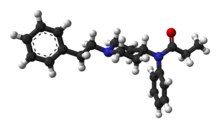Duragesic
 |
|
 |
|
| Clinical data | |
|---|---|
| Trade names | Actiq, Duragesic, Fentora, others |
| AHFS/Drugs.com | Monograph |
| Pregnancy category |
|
| Dependence liability |
Very high |
| Routes of administration |
TD, IM, IV, oral transmucosal, sublingual, buccal |
| Drug class | Opioid |
| ATC code | |
| Legal status | |
| Legal status |
|
| Pharmacokinetic data | |
| Bioavailability | 92% (transdermal) 89% (intranasal) 50% (buccal) 33% (ingestion) |
| Protein binding | 80–85% |
| Metabolism | hepatic, primarily by CYP3A4 |
| Onset of action | 5 minutes |
| Biological half-life |
IV: 10–20 mins (T1/2 β) 2–4 hours (T1/2 ɣ) Intranasal: 6.5 mins Transdermal: 20–27 h Sublingual/buccal (single dose): 5.4–6.3 h |
| Duration of action |
IV: 30–60 minutes 30–40 min |
| Excretion | 60% urinary (metabolites, <10% unchanged drug) |
| Identifiers | |
|
|
| CAS Number | |
| PubChem CID | |
| IUPHAR/BPS | |
| DrugBank | |
| ChemSpider | |
| UNII | |
| KEGG | |
| ChEBI | |
| ChEMBL | |
| ECHA InfoCard | 100.006.468 |
| Chemical and physical data | |
| Formula | C22H28N2O |
| Molar mass | 336.471 g/mol |
| 3D model (Jmol) | |
| Melting point | 87.5 °C (189.5 °F) |
|
|
|
|
Fentanyl (also known as fentanil) is a potent, synthetic opioid pain medication with a rapid onset and short duration of action. It is a potent agonist at the μ-opioid receptors. Fentanyl is 50 to 100 times more potent than morphine.
Fentanyl was first made by Paul Janssen in 1960, following the medical inception of pethidine (also known as meperidine, marketed as Demerol) several years earlier. Janssen developed fentanyl by assaying analogues of the structurally related drug pethidine for opioid activity. The widespread use of fentanyl triggered the production of fentanyl citrate (the salt formed by combining fentanyl and citric acid in a 1:1 stoichiometric ratio), which entered medical use as a general anaesthetic under the trade name Sublimaze in the 1960s. Following this, many other fentanyl analogues were developed and introduced into medical practice, including sufentanil, alfentanil, remifentanil, and lofentanil.
In the mid-1990s, fentanyl was introduced for palliative use with the fentanyl patch, followed in the next decade by the introduction of the fentanyl lollipop, dissolving tablets, and sublingual spray which are absorbed through the skin inside the mouth. As of 2012[update], fentanyl was the most widely used synthetic opioid in medicine. In 2013, 1700 kilograms were used globally.
Fentanyl is also used as a recreational drug, and this use has led to thousands of overdose deaths each year from 2000 to 2015. Deaths have also resulted from improper medical use. Fentanyl has a relatively wide therapeutic index (270) which makes it a very safe surgical anesthetic when monitored carefully; however, its extreme potency requires careful measurements of highly diluted fentanyl in solution; attempting to accurately measure a dose of pure fentanyl powder is impractical without advanced scientific equipment as an effective dose and a lethal dose of fentanyl powder placed next to each other would be difficult or impossible to differentiate with the naked eye.
...
Wikipedia
